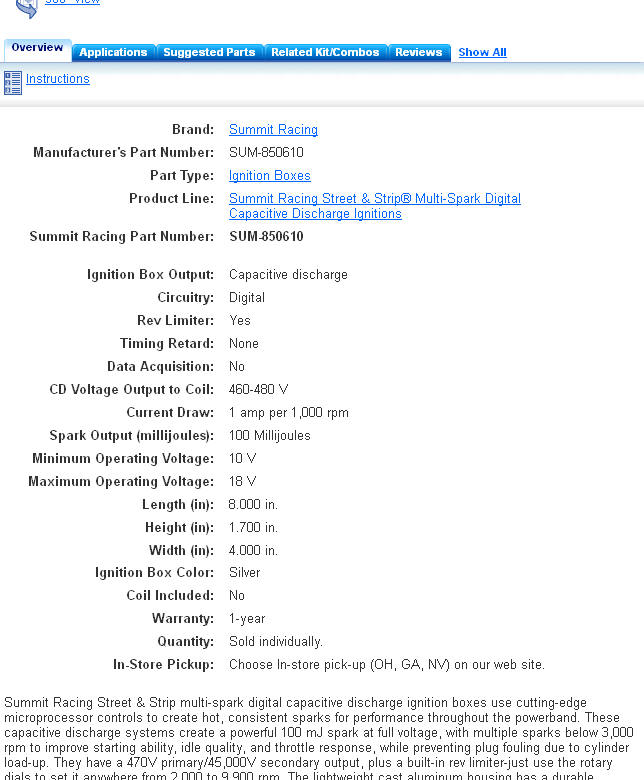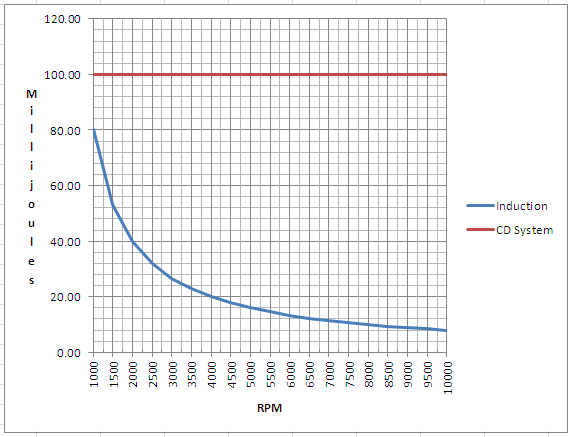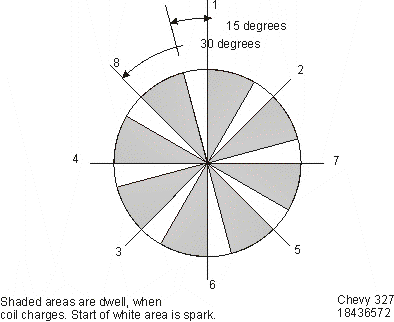
What Makes the Spark?
Our cars have what we call "12 volt" electrical systems. A fully charged car
battery in resting state is around 12.6 volts, a battery being held at full
float charge needs around 13 volts, and a running charging automotive system is
typically in the low to mid 14-volt range.
This low voltage must be
increased to
over 15,000 volts to arc across the spark plug's gap. The resulting spark must have
enough plasma (heat) energy to ignite the mixture. Any extra energy, beyond
reliably lighting the mixture and starting the flame front, has little or no useful
effect. To be sure, excess energy simply eats away at gaps faster. The
igntion voltage requires stepping the 12-volt electrical system up a
few thousand times. The most efficient way to accomplish this is with some form
of energy storage
with a sudden energy or stored charge release. A little bit of energy is stored
over a long time, and then released all at once to generate a high-energy
high-temperature spark. This is where the phrase "spark
discharge" comes from.
Sparks or arcs behave in a unique way.
Initially, there is a
rather high hold-off voltage before any gaps (in the distributor and plug) break
down. Once the gap
"fires" the gap fills with a plasma, causing the arc sustaining voltage
to become quite low. At this point the arc requires much more current and much
less voltage to sustain the plasma. The ideal voltage is very high at first with
a great deal of current surge to back it up. The ideal waveform hits the series gaps
with a very fast application of extreme voltages, then sustains the series arcs at a
much lower voltage and higher current. The arc has to sustain until the combustion
process fully starts, all taking place in a small fraction of a second.
The ignition system operates under the same basic principles as
common low voltage storage
battery charging and starting systems. The ignition system just has much higher
voltage and, because of the short discharge time and much lower power, a whole lot less
overall energy.
In systems like this we have to consider load time and
power levels. To do this, engineers measure the stored and used
energy in joules, which is the number of watts over a
certain time period. One joule is one watt-second. A car battery is a few million joules, while an ignition system
might be down around 1/10th of one joule!
Both systems
accumulate energy in some storage device over a long time period to satisfy a short duration
much higher peak load.
With the car electrical system, the alternator charges a storage battery over minutes and hours to
both meet the
starter's high peak energy cranking demand and to "fill in" missing power whenever
the vehicle's electrical load exceeds
the alternator's output. The ignition system stores much less energy, with a
charging period measured in thousandths of a second and an extremely short spark discharge
time.
The standard measurement of ignition energy is the joule. A joule is defined as one watt-second of energy (USA home electrical service bills in kilowatt-hours). One joule can be one watt for one second, 100 watts for 1/100th of a second, or any other time multiplied by power combination that comes out as one watt-second. Typical ignitions are in the 50 millijoule (50 mJ) to 200 millijoule (200 mJ) range, or .05 joules to .2 joules. The Ford factory TFI, for example, was around the lower 100 mJ range. You'll see why these numbers are important when comparing ignition systems.
Spark Power and Time
The standard four-cycle engine spark repetition time rate
formula is t=120/(N*RPM) where t is seconds and N is number of cylinders. A V8
at 6000 RPM has 120/48000 = .0025 seconds between repeating standard ignition
system sparks. This is 2.5 milliseconds between sparks, or 1/.0025 = 400 sparks
per second.
The crankshaft of a 6000 RPM engine rotates 360*RPM/60 =
36,000 crank rotational degrees per second. We can simplify this to
seconds per degree = 1/36,000 or .0000278 seconds per degree at 6k RPM. At 6,000 RPM every one degree crank position
change takes about 28 millionths of a second (28uS). 1 degree spark timing change is just 28 uS
at 6,000 RPM. We can see how recovery time might be a problem.
Even firing fouled plugs, poorly
burning mixtures, or difficult to light mixtures spark only needs to last
several degrees of crank
rotation. A spark duration of 20-30 degrees will pretty much cover the time to
obtain any useful mechanical power from a poorly firing or misfired cylinder. If
ignition time goes beyond a 5-10 degrees there can be substantial power loss.
10 degrees at 6k RPM is 10*28uS = 280 uS. Spark lasting beyond 0.2 mS
(.0002 seconds) is pretty much wasted. After 0.2 mS, the likelihood of obtaining
any meaningful power from a misfire or incomplete ignition rapidly decreases.
At 0.8 mS, the piston would be 29 degrees ATC. The piston will have moved so far below top dead center,
firing the cylinder would provide virtually no power.
There is little reason to worry about a long spark or multiple sparks at speeds much above idle, and a long spark will actually reduce intensity at the optimum spark point. We really want all spark energy concentrated at the optimum ignition time. Spark duration beyond a few degrees of crank rotation is largely a waste, except for air pollution reduction during misfires. Based on a spark duration of 30 degrees and a battery drain of 8 amperes in an ideal induction ignition breaker point system:
| Cylinders | Strokes | Amps Avg | Deg Dwell | |
| 8 | 4 | 8 | 30 | |
| RPM | btwn spk time mS | Spk Duratn mS | Dwell t Max mS | Max millijoules |
| 1000 | 15.00 | 5.00 | 10.00 | 80.00 |
| 1500 | 10.00 | 3.33 | 6.67 | 53.33 |
| 2000 | 7.50 | 2.50 | 5.00 | 40.00 |
| 2500 | 6.00 | 2.00 | 4.00 | 32.00 |
| 3000 | 5.00 | 1.67 | 3.33 | 26.67 |
| 3500 | 4.29 | 1.43 | 2.86 | 22.86 |
| 4000 | 3.75 | 1.25 | 2.50 | 20.00 |
| 4500 | 3.33 | 1.11 | 2.22 | 17.78 |
| 5000 | 3.00 | 1.00 | 2.00 | 16.00 |
| 5500 | 2.73 | 0.91 | 1.82 | 14.55 |
| 6000 | 2.50 | 0.83 | 1.67 | 13.33 |
| 6500 | 2.31 | 0.77 | 1.54 | 12.31 |
| 7000 | 2.14 | 0.71 | 1.43 | 11.43 |
| 7500 | 2.00 | 0.67 | 1.33 | 10.67 |
| 8000 | 1.88 | 0.63 | 1.25 | 10.00 |
| 8500 | 1.76 | 0.59 | 1.18 | 9.41 |
| 9000 | 1.67 | 0.56 | 1.11 | 8.89 |
| 9500 | 1.58 | 0.53 | 1.05 | 8.42 |
| 10000 | 1.50 | 0.50 | 1.00 | 8.00 |
A standard CD system handily beats a theoretically perfect induction system at high RPM, because energy millijoules in a CD system are almost constant across the RPM range. For example, this small Summit Racing CD system (made by MSD) has over 100 millijoules of energy storage, and draws only 1 amp per 1000 RPM. It has more spark at 8000 RPM than a conventional inductive system running at 8 amperes can supply at 1000 RPM!

Ignition Spark Intensity
Spark intensity or quality varies with the storage and release of energy. We have to fill the storage reservoir of some type (like charging a battery), and release that energy at the appropriate time. There are two factors being traded when storing energy:
Energy storage is a direct product of current level over time. The less time we have to charge the system, the more current required. Electrical energy is measured in watt-seconds or joules. A charge or discharge rate of one ampere for one second is one joule. j = t*I where t is time in seconds and I is current in amperes. Car ignitions are in fractions of a joule.
Ignition Types
There are two common types of ignition systems, induction or "fly-back" coils and capacitor discharge or CD ignitions. Both systems work by energy storage, and the sudden release of that stored energy.
Typically, this is how both types compare in spark energy (based on a demand of 8 amperes maximum current):

Induction style ignition coils do not act as transformers. Consequentially, increasing primary voltage does not directly increase induction coil spark voltage. Increasing coil current or dwell time up to the point of core magnetic flux saturation, and reducing loading across the coil, increases spark voltage. Increasing voltage may or may not increase spark, the result being dependent on dwell time, dwell current, plug resistance, and coil characteristics.
Multiple Coil Systems
Multiple coil systems have the advantage of increasing dwell time. For every doubling of coil numbers, dwell time also doubles. In the ideal case doubling stored energy at any given RPM, up to a limit of core saturation.
In 1985, we manufactured a multiple coil marine system. Each coil was capable of storing 40 millijoules at saturation. To prevent excessive current at slow speeds, the coil was current limited by external electronics. That system produced a flat spark energy curve up to about 5000 RPM. Above 5000, energy gradually tapered off.
This system produced around the same spark energy with any battery voltage over 8 volts. This is because the system was current limited, or ballasted. If the system was not current limited or ballasted, it would have drawn excessive current at low speeds.
Dwell
Dwell (coil charge time) is best explained by looking at an old point style ignition. The dwell for a 1964 327 Chevy engine is shown below:

Dwell is normally given in distributor degrees. With eight cylinders, there are 360 distributor degrees. Spark occurs at point opening, with each spark point 45-degrees apart. Allowing for wear, opening and closing times, and time to fully discharge coil, dwell must be set some reasonable number below 45 degrees. Typically, this is around 30 degrees in a point-type ignition.
Electronic ignitions respond faster while avoiding mechanical friction-wear and contact arc problems. Significant reduction of wear and more consistent operation allows electronic systems to use higher dwell than breaker point systems, with dwells as high as 40 degrees possible.
Coil Inductance (Stopped ignore all after this point)
Coil inductance is normally in millihenries, or thousandths of a Henry. Coil inductance, along with voltage and external resistance or current limiting, is what controls the charge time (dwell) required to fully charge an induction coil. There is a time constant, which is the time required to reach and there is a transient time. The formulas are:
Time constant = L/R
Transient time, or the time to reach what is normally considered full charge, is five times the time constant
The ballast resistor or ballast current should be set to fully saturate the coil at minimum operating voltage. Let's assume that current, in a heavy duty coil, is 8 amperes and the battery is always above 12 volts. This would be 12/8 = 1.5 ohms total ballast resistance (including coil R), or a current of 8 amps in a solid state current limited ignition.
An 8 mH coil impedance with a 1.5 ohm ballast has a time constant of .008/1.5 = 5.3 milliseconds. The transient time is five times that, or 26.7 mS.
An engine rotates .006*RPM = degrees per second. A 5000 RPM engine would rotate 30 degrees per second.
This is 1/.006*RPM = seconds per RPM degree. The 5000 RPM example would take .033 seconds (33 milliseconds) to move 1 degree.
At 5000 RPM an 8 mH coil with 1.5 ohm total ballast and coil resistance would fully saturate.
Spark would occur every 45 degrees in a V8. That would take 45*(1/.006*RPM ) = The dwell time would be